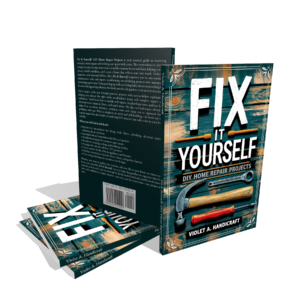Fix It Yourself DIY Home Repair Projects – Complete Guide to Home Improvement and Maintenance

Transform your home with confidence using proven DIY home repair techniques that save money and build essential skills. Every homeowner faces those frustrating moments when something breaks, leaks, or stops working properly. Instead of reaching for your phone to call expensive professionals, imagine having the knowledge and confidence to tackle these home improvement challenges yourself. This comprehensive ebook empowers both beginners and experienced DIYers to master essential home maintenance tasks through clear, step-by-step instructions and practical safety guidance.
Whether you’re dealing with a leaky faucet, patching drywall, or handling basic electrical work, this DIY home repair guide provides the foundation you need to become self-sufficient. The book emphasizes smart tool selection, proper safety protocols, and cost-effective solutions that help you maintain your home while developing valuable long-term skills.
What You’ll Discover
- Essential Tool Mastery: Learn which DIY tools are truly necessary and how to use hammers, screwdrivers, levels, and tape measures effectively for home repairs
- Step-by-Step Repair Techniques: Master common home maintenance tasks including plumbing fixes, wall repairs, and electrical work with clear instructions
- Safety-First Approach: Discover critical safety measures and protective gear usage to prevent accidents during DIY home improvement projects
- Cost-Saving Strategies: Learn how to tackle expensive repair tasks yourself and avoid costly professional service calls for routine maintenance
- Confidence Building Methods: Overcome intimidation and develop the self-assurance to handle increasingly complex home repair challenges
- Troubleshooting Solutions: Access practical advice for diagnosing problems and finding effective fixes for common household issues
Why This Book Matters
Home ownership comes with unexpected challenges, and professional repair costs continue to rise. This DIY home repair guide bridges the gap between helplessness and expertise, providing practical solutions that immediately impact your budget and confidence. The book’s emphasis on safety and skill-building ensures you’ll approach each project with the right knowledge and preparation, reducing the risk of mistakes that could cost more than hiring professionals.
Unlike generic home improvement guides, this resource focuses on real-world applications and common scenarios every homeowner encounters. The practical approach helps you build a foundation of DIY techniques that expand over time, creating long-term value and self-sufficiency in home maintenance.
Key Features
This comprehensive ebook spans multiple chapters covering essential DIY home repair topics from basic tool usage to advanced troubleshooting techniques. Available as an instant digital download, you’ll receive immediate access to step-by-step instructions, safety protocols, and cost-saving strategies. The format allows for easy reading on any device, with practical exercises you can reference while working. Also available as audiobook on Google Play Books and Spotify for convenient listening during commutes or while organizing your workshop.
Frequently Asked Questions
Is this DIY home repair guide suitable for complete beginners?
Absolutely! The book starts with fundamental concepts like basic tool selection and safety protocols. Each project includes clear, step-by-step instructions that assume no prior experience, making it perfect for homeowners just starting their DIY journey.
What types of home repair projects are covered in this guide?
The guide covers common household repairs including plumbing fixes, drywall patching, basic electrical work, and general maintenance tasks. Each section provides practical techniques you can apply immediately to solve real problems in your home.
How much money can I realistically save using these DIY techniques?
Professional repair costs vary by region, but homeowners typically save 50-80% by handling basic repairs themselves. Simple fixes like leaky faucets or wall patches often cost hundreds when professionally done but just dollars in materials for DIY repairs.
Get Your Copy Today
Transform your home maintenance approach with this comprehensive DIY home repair guide. Available for instant download at just $6.99, this ebook provides exceptional value compared to expensive repair service calls or lengthy courses. Also available as audiobook on Google Play Books and Spotify for flexible learning. Purchase your copy through all major ebook retailers including Apple Books, Barnes & Noble, and Kobo to begin building your home improvement confidence today.
Watch the Video Review

